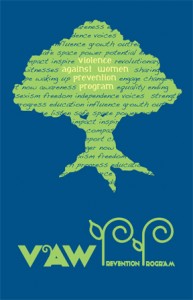Overview
Grounded in a social justice and feminist perspective, the Violence Against Women Prevention Program (VAWPP) is dedicated to addressing and preventing all forms of sexual violence through education, outreach, and advocacy.
History
In September 1979, a woman was brutally assaulted one afternoon while jogging on the University of Connecticut Storrs campus. The evening of the attack, a group of women involved with the Women's Semester class of the Women' s Studies Program wanted to take some action. They met with the Diana Woolis, then Director of the Women's Center, and Pat Miller, the instructor of the Women's Semester course, to discuss what women could do in protest of the continued violence against women at UConn. A meeting, open to anyone concerned with violence against women, was held at which further action was contemplated. A Day of Metanoia, as mechanism provided by the University to hold a day of reflection and organized protest, was the result of that meeting.
This day was observed on Thursday, October 4, 1979, and was considered the first step in confronting the issue of violence in the community. Workshops were held in every dormitory, in many classrooms, and various other places within the University. In the evening, there was a Speak Out, held in the Student Union Ballroom. Members of the University and surrounding community were invited to let the University know how they felt about violence in there community. Over a thousand people attended the Speak Out and the candle-light procession through campus that followed. The following is a statement from the Women's Center Report on the Day of Metanoia:
On Thursday, October 4, 1979, the University of Connecticut observed a Day of Metanoia as a first step in confronting the issue of violence in our community. Specific acts of personal attack, property destruction and racism that have aroused deep concern are rooted in apathy, prevailing attitudes of sexism and racism, and willingness to condone violence by others. Our objective for the day was to ask each member of the community to look at him or herself, to ask how he or she contributed to violence and, in turn, how individually as well as institutionally we could contribute to reducing and eliminating violence. We hope to promote light rather than heat, reflection rather than accusation.
Continued discussions about the different possibilities and strategies which could be implemented to inform the UConn community led to the formation of the Rape Education Program (REP) in September of 1980. The program training and strategic plan was developed by 3 undergraduate women, Charlotte Merrill, Nadine Garnett, and Elizabeth Patrie, along with Center Director Diana Woolis, with the initial objectives of:
- informing the campus of the problems of sexual assault and sexual harassment;
- defining and explaining both;
- letting know with whom they can talk and file complaints and;
- encouraging people to talk about these problems.